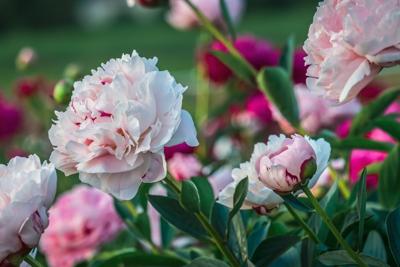What happens when your peonies are peak-ed?
Well, if youČËŃýÉ«ÇéƬ™re a mom, a doctor, and a gardener, you get busy diagnosing the problem. Just like an illness in your child or patient, there are several possibilities.
ItČËŃýÉ«ÇéƬ™s the same for plants.
A friend ČËŃýÉ«ÇéƬ” a mom of three boys, and a doctor I often call on ČËŃýÉ«ÇéƬ” needed my help. Her peonies are not healthy. She sent pictures, and I gasped when I saw the damage.
Mid to late May is when those full, romantic blooms appear. They hang heavy on the plant stems, so using a brace to support the plants will help the blooms stay upright.
I place this wire frame early in the spring when the plant breaks through the ground and begins to grow. Of course, I check on the placement as the plant gains height and fills out to ensure it is doing its job and the stems are positioned correctly. As the plant grows, the frame becomes invisible.
The three peonies in my garden were here before me. IČËŃýÉ«ÇéƬ™m not really sure how old they are, but peonies can live and bloom for several decades. A few years ago, I added three plants to the area in hopes of creating a legacy of peonies in this space.
It is best to plant in the fall. This allows the plant to become established before freezing temps. Be patient. It may take two years for your blooms to reach their potential. Trust me, a full peony bloom is worth the wait.
Be sure to pick a sunny spot; peonies need at least six hours of sun to thrive. Spring rains will add to the health and beauty of the blooms. Once the plant blooms, the flowers can last up to 10 days ČËŃýÉ«ÇéƬ” that is, if you can resist cutting a bouquet for indoors.
If bringing the flowers indoors, dunk them in water first. Ants love peonies! Be sure to trim back the leaves and use a vase tall enough to support the stems and keep the flowers from extreme drooping.
Despite peoniesČËŃýÉ«ÇéƬ™ low maintenance, problems do happen. Leaves may begin to have rust spots or peony pennies. This is peony blotch, sometimes called peony measles, caused by a fungus usually in the spring as the plant prepares to bloom. It wonČËŃýÉ«ÇéƬ™t kill the peony, but if not addressed, it will reoccur year after year, eventually affecting the plantČËŃýÉ«ÇéƬ™s health.
This can happen when the plant grows in a wet area without enough sunshine. Remember, plants need proper air circulation. Give them space when planting and trim stems to help reduce humidity. This airflow will also help to keep the leaves dry.
To treat blotch, trim the infected leaves from the plant and remove them from the garden bed. Do not add them to your compost pile. I would also spray with a fungicide now. As the plant begins to die back in the fall, remove all foliage and stems from the garden bed to limit fungal matter that will overwinter.
In the spring, when the shoots appear, consider applying a fungicide weekly until the flowers bloom. I donČËŃýÉ«ÇéƬ™t like using chemicals in my garden, but sometimes it is necessary. If you are strictly organic, keep foliage trimmed throughout the season.
Peony blotch should not prevent your plant from blooming. Enjoy the blooms and treat the disease.
DonČËŃýÉ«ÇéƬ™t let the thought of blotch scare you. Peonies are a wonderful plant and are relatively disease-free. They produce marvelous blooms in white and shades of pink. The plants can live for generations. For me, they are a marker that spring is fading into summer and yet again the garden is changing into a new version of itself.








